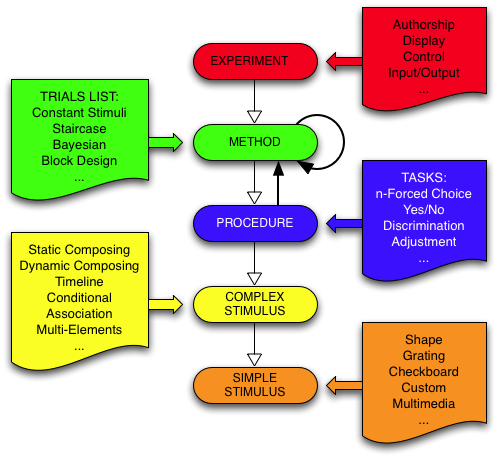Creating a new experiment in Psykinematix is a simple process so long as you can convert your experimental design into the structure displayed in the "Design Panel". This structure consists always of a hierarchical representation of a set of events with each event corresponding to one aspect of your design. Psykinematix is optimized to deal with experimental paradigms that follow the Method/Procedure/Stimulus design illustrated below:

This simple hierarchical description of the experimental protocol is composed of the following events:
- Experiment: the root event that specifies the authorship information, display settings, independent variables, and input/output devices to be used during the experiment;
- Method: this event specifies how the dependent variables change with each trial: method of constant stimuli, staircase, bayesian estimation, and block design are all supported;
- Procedure: this event specifies the subject’s task (forced-choice, yes/no, discrimination, adjustment), how the subject provides the responses (i.e. which input for a given choice) and some trial properties;
- Stimuli: these events specify the stimulation presented to the experimental subject. Stimuli can be simple or complex, static or dynamic, built-in or custom, or even imported from a file.
This simple hierarchy describes events that are functionally linked during the execution of the protocol:
- The experiment event configures the session, and then executes the method event.
- The method event runs the experimental loop by executing a procedure event for each trial and receives from the procedure event whether the subject's response to the trial was correct or incorrect.
- The procedure event executes the stimulus events and waits for the subject’s response. The subject’s response is sent back to the method event if this information is required to set up the next trial.
- The stimulus events generate all stimuli on the fly and render them with the specified values from the independent and dependent variables.
In Psykinematix a typical experimental design simply looks like this:

This simple tree structure permits the creation of relatively complex experiments because events like the Method or Procedure embed a great deal of the complexity behind the experimental protocol. Note that the inter-level relationship between the events and their order at each level of the hierarchy are critical for the experimental design to make sense. A Wizard which simplifies the design process of "canned" experiments is also available.
To learn more about the Experiment Design Panel and the events, please refer to the following sections:
Experiment Designer
Experiment Event
Method Event
Procedure Event
Stimuli Events



